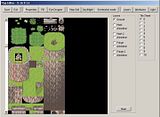Anna Comnena Posted October 11, 2007 Author Share Posted October 11, 2007 There are many mapping tutorials out there, most of them are good, and so I was hesistant to write one myself. One thing I have noticed about them all, is that they are concerned with maps on a map-to-map basis. However, your gameworld isn't a single map, it is the vast territory as depicted by all of your maps combined - so why not map with that in mind?I'm now mapping with a style that allows me to make several maps of good quality at the same time, which makes the mapping go faster, and the gameworld expand much more than usual. In a way this type of mapping is a bit more mechanical, like a production line type of mapping: I go through the area I'm working on (I call these areas "zones" or "regions"), do one step on all maps, then the next step, etc. So I basically get X amount of maps done at roughly the same time, instead of having 1 map done and X blank maps left. Dealing with these regions, instead of maps one-on-one, also helps put the entire gameworld more in focus, since you are dealing with a larger piece of it at a given time._But, I do realize this method won't work with everyone, and although I can map quickly, it still does take much more time to commit to this method of using zones instead of just working on single maps. So right now I will just list some aesthetic tips to make normal maps better:_**Avoid overuse of straight lines.** Nature isn't a bunch of straight lines: between the many forces of erosion (wind, water, gravity), many nooks, cranniess, gullies, and canyons will be carved out of a mountain. Also not only does a straight block for a mountain look unnatural, it also looks repetitive.**Limit repetitive tiles.** This is the main thing about tileset mapping, is you are making a map of often the same tile. So you need to avoid repetition as much as you can, especially with cliff faces. This can often be avoided by making the cliff curve inward and outward often, related to the first tip.**Terrace your hills and mountains instead of having a high cliff.** This is essentially tip one, but used vertically. Often people will make their mountains a big block of a high cliff, which ends up looking too straight, and also looks repetitive. The thing is, RMXP tilesets come with a great pre-set height that is easy to place on your map:[](http://img.photobucket.com/albums/v400/annacomnena/gfx/map%20tutorials/mt-cliffsize.jpg)**Vary the amount of trees and foliage** Don't use the exact same tree and bush all over the place, have atleast a couple vari.ations of them. Again, this helps repetition, the primary enemy that mappers of tileset style maps should avoid. In the same light, however, you don't want to have to much difference, as often in one area the foliage will be the same. For example planting a bunch of bright tropical flowers in a dark mountain forest doesn't look right, nor would mushrooms growing in the middle of a desert flat.Alright, those are probably my main concerns with what mappers need to work on, in my opinion.I will make a tutorial about my "regional mapping" style, using an example area of 4 maps, in the next post (getting example screenshots and writing it takes longer than the mapping does). If there is demand for it as well, I may make an advanced tutorial dedicated to terracing and mountainous areas (since that is where most of my criticisms come from).Anyway, if you are not interested in the methods used to make several maps at the same time, then you don't need to read ahead… Link to comment Share on other sites More sharing options...
soulsoldier2 Posted July 7, 2012 Share Posted July 7, 2012 super work Link to comment Share on other sites More sharing options...
CrowsKnight Posted March 8, 2014 Share Posted March 8, 2014 [ask]what eclipse version?? Link to comment Share on other sites More sharing options...
Growlith1223 Posted March 8, 2014 Share Posted March 8, 2014  Link to comment Share on other sites More sharing options...
kibbelz Posted March 9, 2014 Share Posted March 9, 2014 +1 and locked Link to comment Share on other sites More sharing options...
Recommended Posts
Create an account or sign in to comment
You need to be a member in order to leave a comment
Create an account
Sign up for a new account in our community. It's easy!
Register a new accountSign in
Already have an account? Sign in here.
Sign In Now